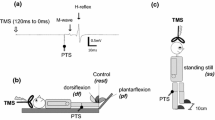In healthy humans, we recorded the H reflex (EMG discharge from the soleus muscle) evoked by transcutaneous stimulation of the tibial nerve. Changes in the magnitude of the reflex discharge within the premotor period preceding the movement of the ipsilateral upper limb (elbow joint flexion performed after a light signal; the respective EMG was recorded from the m. biceps brachii) were examined. The H reflex magnitude began to increase 80-90 msec prior to initiation of forearm flexion; such facilitation reached the maximum synchronously with the development of EMG discharges of the biceps. Tonic excitation of motoneurons of the m. soleus related to moderate voluntary plantar flexion of the foot exerted no significant influence on facilitation of the H reflex within the premotor period. The intensity of background soleus EMG activity did not undergo significant changes during the above time interval. The obtained data indicate that forward facilitation of the H reflex within the premotor period of the voluntary movement of the ipsilateral upper limb is due to the processes developing in the presynaptic part of the arc of this reflex. We hypothesize that weakening of background presynaptic inhibition of terminals of Ia afferents of the m. soleus under the action of central motor commands is the reason for such modifications.
Similar content being viewed by others
References
P. J. Cordo and V. S. Gurfinkel, “Motor coordination can be fully understood only by studying complex movements,” Prog. Brain Res., 143, 29–38 (2004).
M. L. Latash, V. Krishnamoorthy, J. P. Scholz, and V. M. Zatsiorsky, “Postural synergies and their development,” Neural. Plast., 12, Nos. 2/3, 119–130 (2005).
F. B. Horak, “Postural orientation and equilibrium: what do we need to know about neural control of balance to prevent falls?” Age Ageing, 35, Suppl. 2, ii7–ii11 (2006).
S. Bouisset and M. C. Do, “Posture, dynamic stability, and voluntary movement,” Neurophysiol. Clin., 38, No. 6, 345–362 (2008).
M. J. Santos, N. Kanekar, and A. S. Aruin, “The role of anticipatory postural adjustments in compensatory control of posture: 1. Electromyographic analysis,” J. Electromyogr. Kinesiol., 20, No. 3, 388–397 (2010).
L. Gerilovsky and D. Philipova, “Anticipatory reduction of the muscle activity associated with self-triggered electrical stimulation of mixed nerves and mechanical taps on muscle tendons,” Acta Physiol. Pharmacol. Bulg., 26, No. 3, 167–170 (2001).
D. J. Crammond and J. F. Kalaska, “Neuronal activity in primate parietal cortex area 5 varies with intended movement direction during an instructed-delay period,” Exp. Brain Res., 76, No. 2, 458–462 (1989).
R. J. Nelson, B. N. Smith, and V. D. Douglas, “Relationships between sensory responsiveness and premovement activity of quickly adapting neurons in areas 3b and 1 of monkey primary somatosensory cortex,” Exp. Brain Res., 84, No. 1, 75–90 (1991).
M. A. Lebedev, J. M. Denton, and R. J. Nelson, “Vibrationentrained and premovement activity in monkey primary somatosensory cortex,” J. Neurophysiol., 72, No. 4, 1654–1673 (1994).
E. Pierrot-Deseilligny and D. Mazevet, “The monosynaptic reflex: a tool to investigate motor control in humans. Interest and limits,” Neurophysiol. Clin., 30, No. 2, 67–80 (2000).
E. P. Zehr, “Considerations for use of the Hoffmann reflex in exercise studies,” Eur. J. Appl. Physiol., 86, No. 6, 455–468 (2002).
M. Knikou, “The H reflex as a probe: pathways and pitfalls,” J. Neurosci. Methods, 171, No. 1, 1–12 (2008).
T. Kasai and T. Komiyama, “Soleus H reflex depression induced by ballistic voluntary arm movement in human,” Brain Res., 714, Nos. 1/2, 125–134 (1996).
É. I. Slivko and G. A. Bogutskaya, “Modulation of the soleus H reflex caused by ballistic voluntary arm movements in humans,” Neurophysiology, 40, No. 2, 130–136 (2008).
A. El-Tohamy and E. M. Sedgwick, “Spinal inhibition in man: depression of the soleus H reflex by stimulation of the nerve to the antagonist muscle,” J. Physiol., 337, 497–508 (1983).
R. Riedo and D. G. Ruegg, “Origin of the specific H reflex facilitation preceding a voluntary movement in man,” J. Physiol., 397, 371–388 (1988).
P. Rudomin, I. Jimenez, M. Solodkin, and S. Duenas, “Sites of action of segmental and descending control of transmission on pathways mediating PAD of Ia- and Ib-afferent fibers in cat spinal cord,” J. Neurophysiol., 50, No. 4, 743–769 (1983).
J. R. Equibar, J. Quevedo, and P. Rudomin, “Selective cortical and segmental control of primary afferent depolarization of single muscle afferents in the cat spinal cord,” Exp. Brain Res., 113, No. 3, 411–430 (1997).
Author information
Authors and Affiliations
Corresponding author
Rights and permissions
About this article
Cite this article
Bogutskaya, G.A., Reznik, A.Y. & Slivko, É.I. Arm Movement-Related Forward Facilitation of the Soleus H Reflex in Humans. Neurophysiology 44, 455–459 (2012). https://doi.org/10.1007/s11062-012-9317-6
Received:
Published:
Issue Date:
DOI: https://doi.org/10.1007/s11062-012-9317-6



